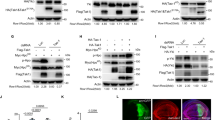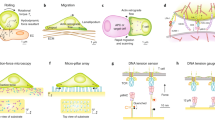Abstract
Striking parallels exist between immune and nervous system cellular signalling mechanisms. Molecules originally shown to be critical for immune responses also serve neuronal functions, and similarly neural guidance cues can modulate immune function. We show here that semaphorin 7A (Sema7A), a membrane-anchored member of the semaphorin family of guidance proteins previously known for its immunomodulatory effects, can also mediate neuronal functions. Unlike many other semaphorins, which act as repulsive guidance cues, Sema7A enhances central and peripheral axon growth and is required for proper axon tract formation during embryonic development. Unexpectedly, Sema7A enhancement of axon outgrowth requires integrin receptors and activation of MAPK signalling pathways. These findings define a previously unknown biological function for semaphorins, identify an unexpected role for integrins and integrin-dependent intracellular signalling in mediating semaphorin responses, and provide a framework for understanding and interfering with Sema7A function in both immune and nervous systems.
This is a preview of subscription content, access via your institution
Access options
Subscribe to this journal
Receive 51 print issues and online access
$199.00 per year
only $3.90 per issue
Buy this article
- Purchase on Springer Link
- Instant access to full article PDF
Prices may be subject to local taxes which are calculated during checkout





Similar content being viewed by others
References
Huh, G. S. et al. Functional requirement for class I MHC in CNS development and plasticity. Science 290, 2155–2158 (2000)
Khan, A. A., Bose, C., Yam, L. S., Soloski, M. J. & Rupp, F. Physiological regulation of the immunological synapse by agrin. Science 292, 1681–1686 (2001)
Wu, J. Y. et al. The neuronal repellent Slit inhibits leukocyte chemotaxis induced by chemotactic factors. Nature 410, 948–952 (2001)
Tordjman, R. et al. A neuronal receptor, neuropilin-1, is essential for the initiation of the primary immune response. Nature Immunol. 3, 477–482 (2002)
He, Z., Wang, K. C., Koprivica, V., Ming, G. & Song, H. J. Knowing how to navigate: mechanisms of semaphorin signaling in the nervous system. Sci. STKE RE1 (2002).
Pasterkamp, R. J. & Kolodkin, A. L. Semaphorin junction: making tracks toward neural connectivity. Curr. Opin. Neurobiol. 13, 79–89 (2003)
Bismuth, G. & Boumsell, L. Controlling the immune system though semaphorins. Sci. STKE RE4 (2002).
Kikutani, H. & Kumanogoh, A. Semaphorins in interactions between T cells and antigen-presenting cells. Nature Rev. Immunol. 3, 159–167 (2003)
Lange, C. et al. New eukaryotic semaphorins with close homology to semaphorins of DNA viruses. Genomics 51, 340–350 (1998)
Xu, X. et al. Human semaphorin K1 is glycosylphosphatidylinositol-linked and defines a new subfamily of viral-related semaphorins. J. Biol. Chem. 273, 22428–22434 (1998)
Angelisova, P., Drbal, K., Cerny, J., Hilgert, I. & Horejsi, V. Characterization of the human leukocyte GPI-anchored glycoprotein CDw108 and its relation to other similar molecules. Immunobiology 200, 234–245 (1999)
Yamada, A. et al. Molecular cloning of a glycosylphosphatidylinositol-anchored molecule CDw108. J. Immunol. 162, 4094–4100 (1999)
Mine, T. et al. CDw108 expression during T-cell development. Tissue Antigens 55, 429–436 (2000)
Holmes, S. et al. Sema7A is a potent monocyte stimulator. Scand. J. Immunol. 56, 270–275 (2002)
Comeau, M. R. et al. A poxvirus-encoded semaphorin induces cytokine production from monocytes and binds to a novel cellular semaphorin receptor, VESPR. Immunity 8, 473–482 (1998)
Bobolis, K. A., Moulds, J. J. & Teelen, M. J. Isolation of the JMH antigen on a novel phosphatidylinositol-linked human membrane protein. Blood 79, 1574–1581 (1992)
Tamagnone, L. et al. Plexins are a large family of receptors for transmembrane, secreted, and GPI-anchored semaphorins in vertebrates. Cell 99, 71–80 (1999)
Bagnard, D., Lohrum, M., Uziel, D., Puschel, A. W. & Bolz, J. Semaphorins act as attractive and repulsive guidance signals during the development of cortical projections. Development 125, 5043–5053 (1998)
Brose, K. & Tessier-Lavigne, M. Slit proteins: key regulators of axon guidance, axonal branching, and cell migration. Curr. Opin. Neurobiol. 10, 95–102 (2000)
Zou, Z., Horowitz, L. F., Montmayeur, J. P., Snapper, S. & Buck, L. B. Genetic tracing reveals a stereotyped sensory map in the olfactory cortex. Nature 414, 173–179 (2001)
Schwob, J. E. & Price, J. L. The development of axonal connections in the central olfactory system of rats. J. Comp. Neurol. 223, 177–202 (1984)
de Castro, F., Hu, L., Drabkin, H., Sotelo, C. & Chedotal, A. Chemoattraction and chemorepulsion of olfactory bulb axons by different secreted semaphorins. J. Neurosci. 19, 4428–4436 (1999)
Soussi-Yanicostas, N. et al. Anosmin-1, defective in the X-linked form of Kallmann syndrome, promotes axonal branch formation from olfactory bulb output neurons. Cell 109, 217–228 (2002)
Nguyen-Ba-Charvet, K. T., Plump, A. S., Tessier-Lavigne, M. & Chedotal, A. Slit1 and slit2 proteins control the development of the lateral olfactory tract. J. Neurosci. 22, 5473–5480 (2002)
Sugisaki, N. et al. Positional cues that are strictly localized in the telencephalon induce preferential growth of mitral cell axons. J. Neurobiol. 29, 127–137 (1996)
Hirata, T. & Fujisawa, H. Cortex-specific distribution of membrane-bound factors that promote neurite outgrowth of mitral cells in culture. J. Neurobiol. 32, 415–425 (1997)
Hynes, R. O. Integrins: bidirectional, allosteric signaling machines. Cell 110, 673–687 (2002)
Ruoslahti, E. RGD and other recognition sequences for integrins. Annu. Rev. Cell Dev. Biol. 12, 697–715 (1996)
Kuruvilla, R., Ye, H. & Ginty, D. D. Spatially and functionally distinct roles of the PI3-K effector pathway during NGF signaling in sympathetic neurons. Neuron 27, 499–512 (2000)
Yip, P. M., Zhao, X., Montgomery, A. M. & Siu, C. H. The Arg-Gly-Asp motif in the cell adhesion molecule L1 promotes neurite outgrowth via interaction with the alphavbeta3 integrin. Mol. Biol. Cell 9, 277–290 (1998)
Chavis, P. & Westbrook, G. Integrins mediate functional pre- and postsynaptic maturation at a hippocampal synapse. Nature 411, 317–321 (2001)
Pfaff, M., McLane, M. A., Beviglia, L., Niewiarowski, S. & Timpl, R. Comparison of disintegrins with limited variation in the RGD loop in their binding to purified integrins alpha IIb beta 3, alpha V beta 3 and alpha 5 beta 1 and in cell adhesion inhibition. Cell Adhes. Commun. 2, 491–501 (1994)
Giger, R. J. et al. Neuropilin-2 is a receptor for semaphorin IV: insight into the structural basis of receptor function and specificity. Neuron 21, 1079–1092 (1998)
Schlaepfer, D. D. & Hunter, T. Integrin signalling and tyrosine phosphorylation: just the FAKs? Trends Cell Biol. 8, 151–157 (1998)
Doherty, P., Williams, G. & Williams, E. J. CAMs and axonal growth: a critical evaluation of the role of calcium and the MAPK cascade. Mol. Cell. Neurosci. 16, 283–295 (2000)
Huang, E. J. & Reichardt, L. F. Neurotrophins: roles in neuronal development and function. Annu. Rev. Neurosci. 24, 677–736 (2001)
Sakai, T. et al. Mouse semaphorin H induces PC12 cell neurite outgrowth activating Ras-mitogen-activated protein kinase signaling pathway via Ca(2 + ) influx. J. Biol. Chem. 274, 29666–29671 (1999)
Fujioka, S. et al. Neurotrophic effect of Semaphorin 4D in PC12 cells. Biochem. Biophys. Res. Commun. 301, 304–310 (2003)
Serafini, T. et al. The netrins define a family of axon outgrowth-promoting proteins with homology to C. elegans UNC-6. Cell 78, 409–424 (1994)
Zhou, X., Suh, J., Cerretti, D. P., Zhou, R. & DiCicco-Bloom, E. Ephrins stimulate neurite outgrowth during early cortical neurogenesis. J. Neurosci. Res. 66, 10544–10563 (2001)
Frank, I. et al. Acquisition of host cell-surface-derived molecules by HIV-1. AIDS 10, 1611–1620 (1996)
de Fougerolles, A. R. & Koteliansky, V. E. Regulation of monocyte gene expression by the extracellular matrix and its functional implications. Immunol. Rev. 186, 208–220 (2002)
Milner, R. & Campbell, I. L. The integrin family of cell adhesion molecules has multiple functions within the CNS. J. Neurosci. Res. 69, 286–291 (2002)
Schwenk, F., Baron, U. & Rajewsky, K. A cre-transgenic mouse strain for ubiquitous deletion of loxP-flanked gene segments including deletion in germ cells. Nucleic Acids Res. 23, 5080–5081 (1995)
Pasterkamp, R. J., De Winter, F., Holtmaat, A. J. & Verhaagen, J. Evidence for a role of the chemorepellent semaphorin III and its receptor neuropilin-1 in the regeneration of primary olfactory axons. J. Neurosci. 18, 9962–9976 (1998)
Ivankovic-Dikic, I., Gronroos, E., Blaukat, A., Barth, B. & Dikic, I. Pyk2 and FAK regulate neurite outgrowth induced by growth factors and integrins. Nature Cell Biol. 2, 574–581 (2000)
Acknowledgements
We thank A. Ghosh, D. D. Ginty and J. T. Yang for comments on the manuscript; Y. Wu for excellent technical assistance; the Johns Hopkins Transgenic Core Facility for blastocyst injections and discussions; members of the Kolodkin, Ginty and Ghosh laboratories, and L. Tamagnone and Z. He for helpful discussions; J. F. Cloutier for help with the VNE cultures; R. Kuruvilla for help with the MAPK/FAK experiments; K. Takamiya, R. Huganir, L. H. Rome, M. Tessier-Lavigne, Y. Luo, C.-M. Fan, A. Yamada, B. Lonze and R. J. Giger for constructs and cells. This work was supported by grants from the Netherlands Organization for Scientific Research and Human Frontier Science Program (to R.J.P), and The Kirsch Foundation and NIH/NINDS (to A.L.K.).
Author information
Authors and Affiliations
Corresponding author
Ethics declarations
Competing interests
R.J.P. and A.L.K. declare that they have no competing financial interests. J.J.P. and M.K.S. are shareholders in Amgen Corporation.
Rights and permissions
About this article
Cite this article
Jeroen Pasterkamp, R., Peschon, J., Spriggs, M. et al. Semaphorin 7A promotes axon outgrowth through integrins and MAPKs. Nature 424, 398–405 (2003). https://doi.org/10.1038/nature01790
Received:
Accepted:
Issue Date:
DOI: https://doi.org/10.1038/nature01790
Comments
By submitting a comment you agree to abide by our Terms and Community Guidelines. If you find something abusive or that does not comply with our terms or guidelines please flag it as inappropriate.



